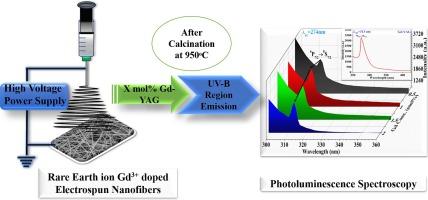Trailblazing 1D gadolinium-doped yttrium aluminium garnet (YAG: Gd3+) nanofibers for UV-optimized applications
Q3 Physics and Astronomy
引用次数: 0
Abstract
This research presents a novel approach to fabricating Yttrium Aluminum Garnet (YAG) nanofibers doped with Gadolinium (Gd3+) ions using the electrospinning technique. Rare earth-doped electrospun nanofibers, known for their exceptional performance, attract significant interest for applications in flexible display devices. While Gd3+-doped YAG materials have been studied, this is the first instance of their synthesis in nanofiber form, enhancing their optical and emission properties, particularly in the ultraviolet-B i.e. UV-B (280–315 nm) range. The study aims to develop and characterize these nanofibers with varying Gd3+ concentrations (x = 0.5, 1, 1.5, 2 mol%), employing techniques like X-Ray Diffraction (XRD), Fourier Transform Infrared Spectroscopy (FTIR), Scanning Electron Microscopy (SEM), Transmission Electron Microscopy (TEM), X-Ray Photoelectron Spectroscopy (XPS), and photoluminescence to analyze structural integrity, surface morphology, and luminescence. XRD confirmed the pure YAG phase after calcination at 950 °C for 2 hrs, and the nanofibers showed a strong emission peak at 313 nm under 274 nm excitation corresponding to the 6P7/2 → 8S7/2 transition, with optimal photoluminescence at 1 mol% Gd3+ doping. These results highlight the potential of Gd3+-doped YAG nanofibers for advanced applications in flexible electronics and UV-based display devices.

用于紫外线优化应用的开拓性 1D 掺钆钇铝石榴石(YAG: Gd3+)纳米纤维
本研究提出了一种利用电纺丝技术制造掺杂钆(Gd3+)离子的钇铝石榴石(YAG)纳米纤维的新方法。掺稀土的电纺纳米纤维以其优异的性能而闻名,在柔性显示器件中的应用引起了极大的兴趣。虽然已经对掺杂 Gd3+ 的 YAG 材料进行了研究,但这是首次以纳米纤维形式合成这种材料,从而增强其光学和发射特性,特别是在紫外线-B(即 UV-B,280-315 纳米)范围内。本研究旨在开发和表征这些具有不同 Gd3+ 浓度(x = 0.5、1、1.5、2 摩尔%)的纳米纤维,并采用 X 射线衍射 (XRD)、傅立叶变换红外光谱 (FTIR)、扫描电子显微镜 (SEM)、透射电子显微镜 (TEM)、X 射线光电子能谱 (XPS) 和光致发光等技术来分析其结构完整性、表面形态和发光特性。在 950 °C 煅烧 2 小时后,XRD 证实了纯 YAG 相;在 274 nm 激发下,纳米纤维在 313 nm 处显示出对应于 6P7/2 → 8S7/2 转变的强发射峰,在掺杂 1 mol% Gd3+ 时光致发光效果最佳。这些结果凸显了掺杂 Gd3+ 的 YAG 纳米纤维在柔性电子器件和紫外显示设备的先进应用中的潜力。
本文章由计算机程序翻译,如有差异,请以英文原文为准。
求助全文
约1分钟内获得全文
求助全文
来源期刊

Results in Optics
Physics and Astronomy-Atomic and Molecular Physics, and Optics
CiteScore
2.50
自引率
0.00%
发文量
115
审稿时长
71 days
 求助内容:
求助内容: 应助结果提醒方式:
应助结果提醒方式:


